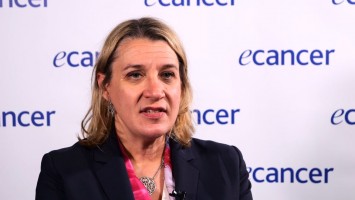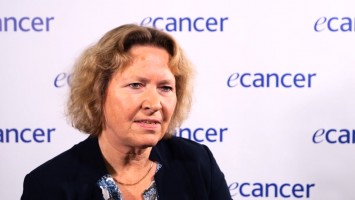EACR 21, 26—29 June 2010, Oslo
Interview with Professor Richard Marais (Institute of Cancer Research, London, UK)
The role of the B-RAF mutation in melanoma treatment
Our primary focus is on melanoma and melanoma, as I’m sure you’re aware, is a deadly form of skin cancer which is on the increase, so in most Western populations melanoma doubles about every ten years. The prognosis for people who have the metastatic form of the disease is very poor so if you catch the disease early, and in 80% of patients this is what happens, you can cure the disease by surgery. But if the patients advance to the metastatic form then the prognosis is poor, the disease doesn’t generally respond to drugs and half of the people will be dead within six to nine months. Only 5% of patients will survive out to five years.
About ten years ago, Mike Stratton and his colleagues discovered that a protein called B-RAF is mutated in about 50% of melanomas and we’ve been interested in understanding the biology and the therapeutic opportunities that the mutations in B-RAF that occur in melanoma can offer. So we have been looking at downstream gene expression changes to try and understand the biology of the disease; we’ve also been looking at the production of drugs to target B-RAF in melanoma and we’ve been looking at making mouse models of melanoma to allow us to understand the genetics.
Regarding the drug discovery programme, we have some interesting compounds which are now showing really good responses in models of melanoma and we’re interested in commercialising those. One of the things that we’ve been particularly interested to try and do is to try and check the specificity of those compounds. So we’ve been generating versions of B-RAF that have mutations that can’t bind to drugs known to target B-RAF and then we make models of those that we can then analyse whether the drug is actually working through its ability to inhibit B-RAF or through what are called non-specific, or off-target, effects where the drug is actually having its therapeutic activity because it’s targeting something else in the tumour cells.
The way we do this is to actually make a specific mutation and a residue called the gatekeeper residue and that will block the drug binding and then we make tumour models using those gatekeeper mutations and we treat the animals bearing those tumours. What we’ve found is that drugs such as a drug which is called PLX4720, which is a drug that was made by Plexxikon, inhibits tumour growth because it targets B-RAF, whereas another drug, which is a perfectly good drug and works very well in kidney cancer called sorafenib, doesn’t target B-RAF in tumours. The ability of that drug to inhibit melanoma growth is because it inhibits other components of the signalling pathway.
If you then compare that data to clinical samples or to clinical results then that makes a lot of sense because what we now know is that sorafenib is not very good against melanoma although, as I say, it works very well in renal cell carcinoma and hepatocellular carcinoma, whereas the Plexxikon drug works very well in melanoma. This is probably because of its ability to target BRAF. So what we can do with these models is we can use them in pre-clinical development of drugs to actually test the specificity of our drugs.
Now the other thing that we’re interested in doing is trying to understand exactly how the drugs work in patients and what we’ve discovered for the B-RAF selective drugs is that they, paradoxically, activate signalling pathways in some cells. So if you have a B-RAF mutation, the drugs inhibit the pathway, whereas if you have a RAS mutation in the cells then what you find is that you get hyperactivation of the signalling pathway which really comes as quite a surprise and it wasn’t something that you would have predicted. We wanted to investigate the mechanisms of this and what we discovered is that when you inhibit B-RAF it acts as a scaffold to activate another protein that’s closely related to B-RAF called C-RAF. So again this is something that you wouldn’t have predicted and we couldn’t have expected and the way it works is that when you inhibit B-RAF using the drugs it forms a direct protein-protein interaction with C-RAF and it drags C-RAF to the plasma membrane and locks C-RAF at the plasma membrane. That allows now the activation machinery to hyperactivate C-RAF and this drives the pathway.
The consequence of this, unfortunately, is that in patients with RAS mutations these drugs would actually work potentially as a tumour promoter rather than a tumour inhibitor. The other thing is that when you give patients these drugs they may have existing pre-malignant lesions in their bodies which have mutations in RAS. Certainly there’s evidence that this happens in patients because patients suffer from skin lesions which may be driven by this mechanism. What we need to do now is we need to understand if the mechanism I’ve just described is what underlies the formation of these skin lesions on the one hand but also try and work out how to use these B-RAF drugs more effectively.
Most of the B-RAF drug responses in patients are short-lived and the patients inevitably relapse with a median relapse, it looks like it’s going to be about nine months. We need to understand why the patients initially respond and then fail, so that’s really, as far as B-RAF drugs go, where the activity is going to be. On the one hand trying to work out whether these skin lesions are driven by the drug because of this B-RAF/C-RAF complex that’s formed and then on the other hand to try and understand the resistance mechanisms.
What’s the next step?
The next step is to get drugs that work better in patients or at least learn how to use the drugs in combination with other drugs to get better responses in patients, so that the responses that patients enjoy are much more long lived.
I think we also need to understand how to treat these skin lesions because, although they are obviously not killing the patient, they are causing them some side effects, that it would be better not to have for the patients.








